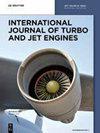旁通比对有限唇缘厚度下声欠膨胀共流射流的影响
IF 0.9
4区 工程技术
Q4 ENGINEERING, AEROSPACE
引用次数: 0
摘要
摘要唇缘厚度为1.5Dp(其中Dp是一次射流的出口直径等于10mm)的声欠膨胀同轴射流的特性,一次射流在喷嘴压力比(NPR)为3、4和5时运行。对于NPR 3运行的主射流,次射流在NPR 2.5、1.4和1.27下运行。对于一次喷射NPR 4,二次喷射运行NPR分别为3.2、1.6和1.4。对于NPR 5主喷流,次喷流NPR分别为3.8、1.89和1.52。使用旁通比(BR)为6.4、1.4和0.7的并流喷嘴进行研究。主射流的核心长度被用作在同轴射流存在的情况下量化主射流的混合的度量。用阴影图技术观察了近场中存在的冲击结构。分析了中心线皮托压力分布、径向扩展和射流芯中存在的波浪。结果表明,高旁路同轴射流的混合效果优于低旁路同轴射流。这种与高旁路同轴射流相关的混合优势在所有膨胀级别上都占主导地位。本文章由计算机程序翻译,如有差异,请以英文原文为准。
Effect of bypass ratio on sonic underexpanded co-flow jets with finite lip thickness
Abstract The characteristics of a sonic under-expanded coaxial jet with lip thickness 1.5D p (where D p is the exit diameter of primary jet equals 10 mm) with the primary jet operating at nozzle pressure ratio (NPR) of 3, 4 and 5. For NPR 3 operating primary jet, the secondary jet operates at NPR 2.5, 1.4 and 1.27. For primary jet NPR 4, the secondary jet operating NPR is 3.2, 1.6 and 1.4. For NPR 5 primary jet, the secondary jet NPR is 3.8, 1.89 and 1.52. The study is performed using a co-flow nozzle of bypass ratio (BR) 6.4, 1.4 and 0.7. The core length of the primary jet is used as a measure to quantify the mixing of the primary jet in the presence of coaxial jet. The shock structure present in the near field was viewed using shadowgraph technique. Centreline pitot pressure distribution, radial spread and waves present in the jet core were analyzed. The results show that the mixing associated with the high bypass coaxial jet is superior to the low bypass coaxial jet. This mixing superiority associated with high bypass coaxial jet prevails all levels of expansion.
求助全文
通过发布文献求助,成功后即可免费获取论文全文。
去求助
来源期刊

International Journal of Turbo & Jet-Engines
工程技术-工程:宇航
CiteScore
1.90
自引率
11.10%
发文量
36
审稿时长
6 months
期刊介绍:
The Main aim and scope of this Journal is to help improve each separate components R&D and superimpose separated results to get integrated systems by striving to reach the overall advanced design and benefits by integrating: (a) Physics, Aero, and Stealth Thermodynamics in simulations by flying unmanned or manned prototypes supported by integrated Computer Simulations based on: (b) Component R&D of: (i) Turbo and Jet-Engines, (ii) Airframe, (iii) Helmet-Aiming-Systems and Ammunition based on: (c) Anticipated New Programs Missions based on (d) IMPROVED RELIABILITY, DURABILITY, ECONOMICS, TACTICS, STRATEGIES and EDUCATION in both the civil and military domains of Turbo and Jet Engines.
The International Journal of Turbo & Jet Engines is devoted to cutting edge research in theory and design of propagation of jet aircraft. It serves as an international publication organ for new ideas, insights and results from industry and academic research on thermodynamics, combustion, behavior of related materials at high temperatures, turbine and engine design, thrust vectoring and flight control as well as energy and environmental issues.
 求助内容:
求助内容: 应助结果提醒方式:
应助结果提醒方式:


